Home / Di-isobutyl Aluminum Hydride (DIBAL) For The Partial Reduction of Esters and Nitriles
Carboxylic Acid Derivatives
Di-isobutyl Aluminum Hydride (DIBAL) For The Partial Reduction of Esters and Nitriles
Last updated: April 10th, 2025 |
DIBAL (Di-isobutyl Aluminum Hydride) – A Bulky Reducing Agent For The Partial Reduction Of Esters and Nitriles
- DIBAL (also known as DIBAL-H or DIBAH) is a strong, bulky reducing agent.
- It’s most useful for the reduction of esters to aldehydes.
- Unlike lithium aluminum hydride, it will not reduce the aldehyde further provided that only one equivalent is added and the reaction mixture is kept cold.
- It will also reduce other carbonyl compounds such as amides, aldehydes, ketones, and nitriles.
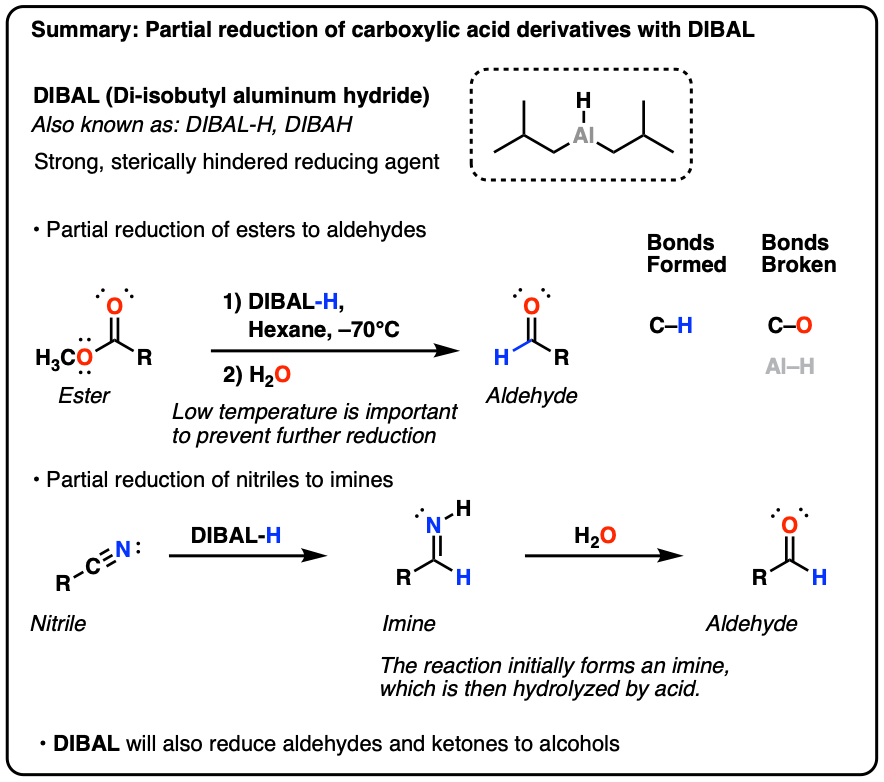
Table of Contents
-
- Di-isobutyl Aluminum Hydride (DIBAL)
- Reduction of Esters to Aldehydes with DIBAL
- DIBAL Reduction of Esters to Aldehydes – The Mechanism
- Reduction of Nitriles with DIBAL
- Reduction of Nitriles with DIBAL – The Mechanism
- Reduction of Aldehydes and Ketones with DIBAL-H
- Summary
- Notes
- Quiz Yourself!
- (Advanced) References and Further Reading
1. Structure of Di-isobutyl Aluminum Hydride (DIBAL)
DIBAL is a strong, bulky reducing agent. Reactivity-wise, it bears a lot of similarity to lithium aluminum hydride.
Unlike LiAlH4 which can (in theory) deliver four equivalents of hydride, DIBAL bears only a single Al-H bond.

This makes the stoichiometry of its reactions much easier to control.
2. Reduction Of Esters To Aldehydes With DIBAL
The most notable reaction of DIBAL is the reduction of esters to aldehydes. Unlike lithium aluminum hydride (LiAlH4), which reduces esters to primary alcohols, reductions with DIBAL can stop at the aldehyde stage if the temperature is kept very low.
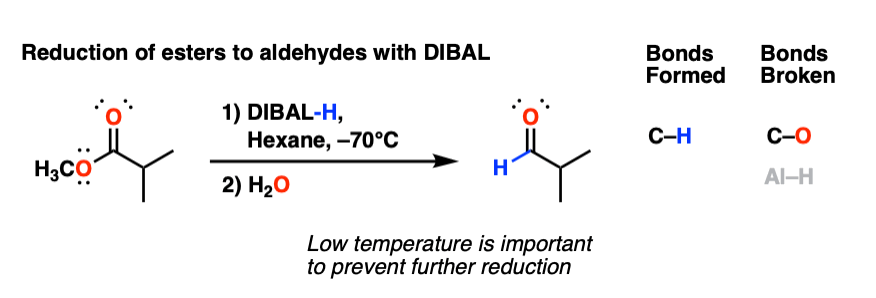
The advantage of DIBAL here is that it is more efficient. If we use LiAlH4, we obtain a primary alcohol, which we would then have to oxidize up to the aldehyde using a reagent such as PCC, Dess-Martin periodinane, or the Swern oxidation. (See post: Alcohol Oxidation)
3. Reduction Of Esters To Aldehydes By Di-Isobutyl Aluminum Hydride: Mechanism
The mechanism for reduction of esters to aldehydes with DIBAL is roughly similar to the familiar addition-elimination mechanism of nucleophilic acyl substitution, with a slightly modified first step. (See post: Nucleophilic Acyl Substitution)
DIBAL-H is neutral, and aluminum, being in the same column of the periodic table as boron, has an empty p-orbital. This makes it a Lewis acid.
The carbonyl oxygen of esters is a Lewis base. So the first step is coordination of the Lewis basic carbonyl oxygen to the Lewis acidic aluminum, to give a species with a negative formal charge on aluminum.
Then comes nucleophilic addition of a hydride (H-) to the carbonyl carbon alongside breakage of the C-O pi bond (form C-H, break C-O pi). (See post: Nucleophilic Addition to Carbonyls)
This forms a new tetrahedral intermediate which is essentially a hemiacetal coordinated to aluminum. (See post: Acetals and Hemiacetals)
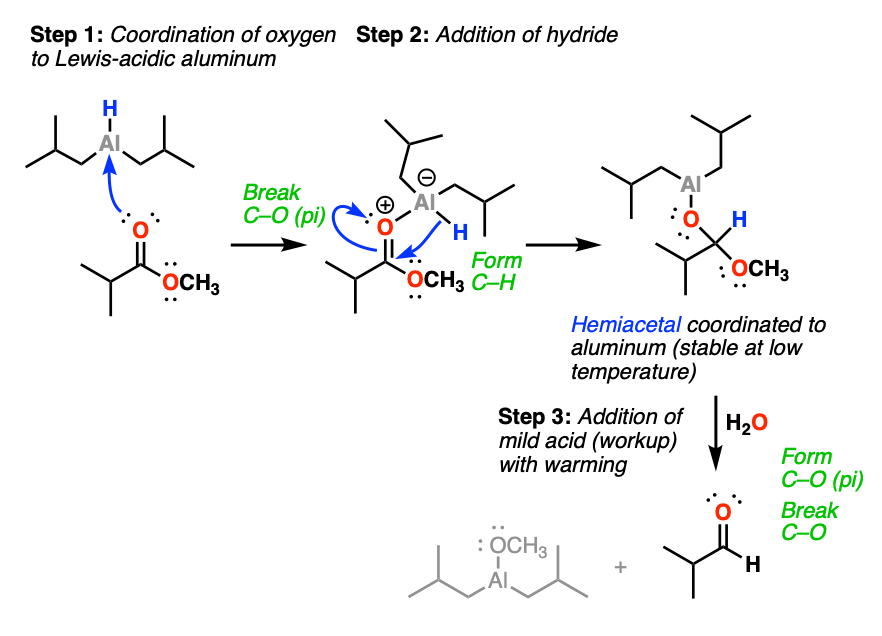
If the temperature is kept low (the convenient dry ice-acetone bath of –78°C is often quoted) , a reaction quenched with acid at this stage will give a neutral hemiacetal which quickly loses ROH to give an aldehyde.
(Note: getting the reaction to stop at the aldehyde stage looks great on paper but can sometimes be difficult to achieve in practice)
4. Reduction Of Nitriles To Imines With DIBAL (And Subsequent Hydrolysis To Aldehydes)
DIBAL will also do partial reductions of nitriles to imines. The imines are then hydrolyzed to aldehydes upon addition of water. (See post: Imines – Properties, Formation and Mechanisms) In this respect DIBAL again differs from LiAlH4, which will reduce nitriles all the way to primary amines.
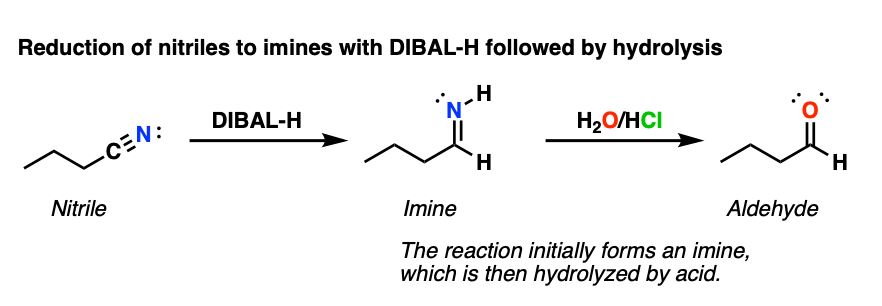
5. Reduction Of Nitriles To Imines: Mechanism
Reduction of nitriles follows a similar mechanism to that for the reduction of esters. Coordination of the Lewis-basic nitrile nitrogen to aluminum is followed by delivery of hydride to the nitrile carbon (form C-H, break C-N (pi) ). This is another example of an addition mechanism.
From this point, quenching the reaction with water results in protonation of the nitrogen and then hydrolysis of the imine to give an aldehyde.
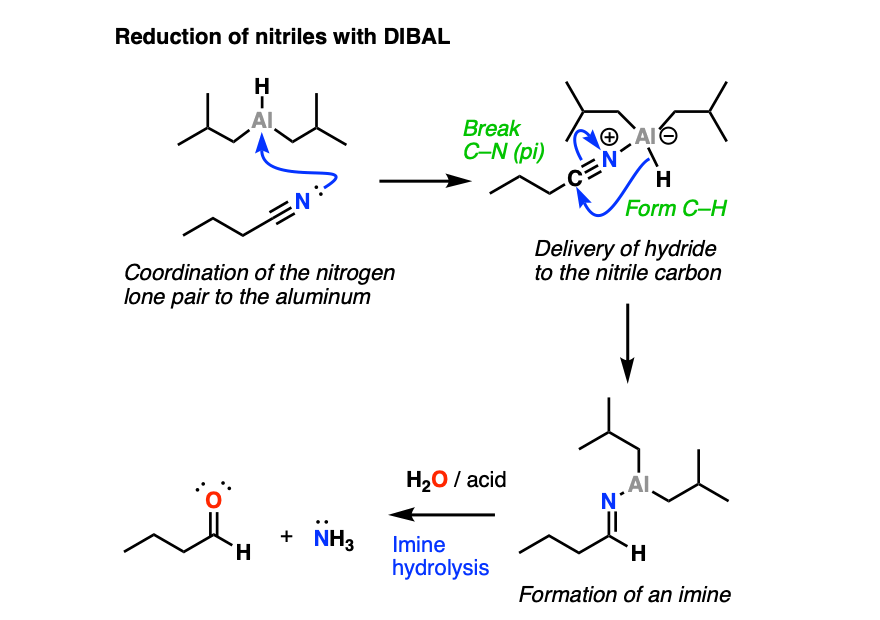
6. Reduction Of Ketones And Aldehydes To Alcohols With Di-IsobutylAluminum Hydride (DIBAL)
Although not often used this way, it’s worth noting that DIBAL can do all the reductions that NaBH4 does, so ketones and aldehydes are reduced to secondary and primary alcohols, respectively.
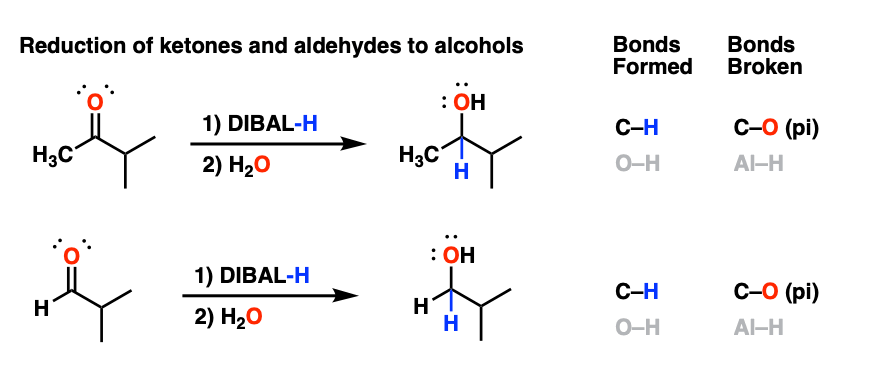
What this means is that DIBAL will not selectively reduce an ester in the presence of an unprotected aldehyde or ketone – those groups will get reduced too.
7. Summary: DIBAL
DIBAL is a useful reagent for the partial reduction of carboxylic acid derivatives. A successful DIBAL reduction of an ester to an aldehyde will save an extra step relative to LiAlH4 followed by oxidation.
Likewise, DIBAL reduction of nitriles gives us a route to aldehydes (after hydrolysis) that is not available through reduction with LiAlH4, which completely reduces nitriles to amines.
Notes
Related Articles
- Nucleophilic Acyl Substitution (With Negatively Charged Nucleophiles)
- Reagent Friday: Sodium Borohydride (NaBH4)
- Nucleophilic Addition To Carbonyls
- Hydrates, Hemiacetals, and Acetals
- Imines – Properties, Formation, Reactions, and Mechanisms
- Hydrolysis of imines to give ketones (or aldehydes) (MOC Membership)
Note 1. What about other functional groups?
From this article (abstract is freely available):
- Alcohols and thiols react with the hydride to give H2 and their corresponding conjugate bases
- Conjugated aldehydes and ketones reduce at C=O to give the allylic alcohols
- Carboxylic acids liberate H2 to give the carboxylates
- Alkyl halides are inert.
- Epoxides are reduced primarily at the less hindered position to give alcohols
- Tertiary amides are reduced to amines, but primary amides only reduce slowly.
Note 2. You can read about the chemistry of DIBAL and more than 80 other reagents in undergraduate organic chemistry in the “Organic Chemistry Reagent Guide”, available here as a downloadable PDF.
Quiz Yourself!
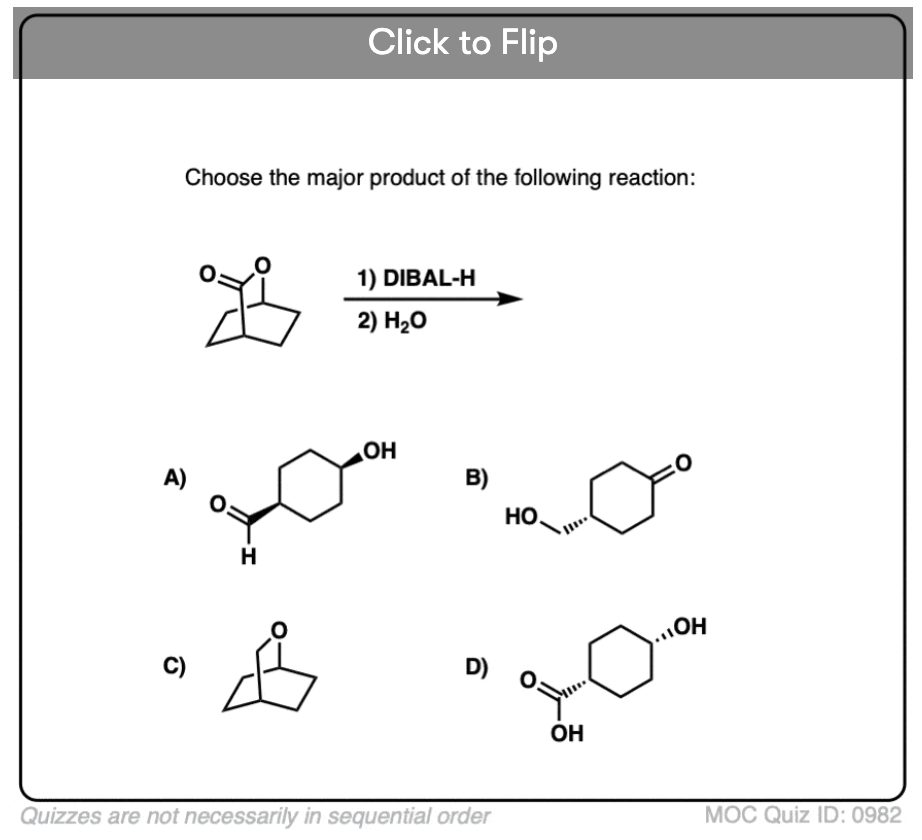
Become a MOC member to see the clickable quiz with answers on the back.
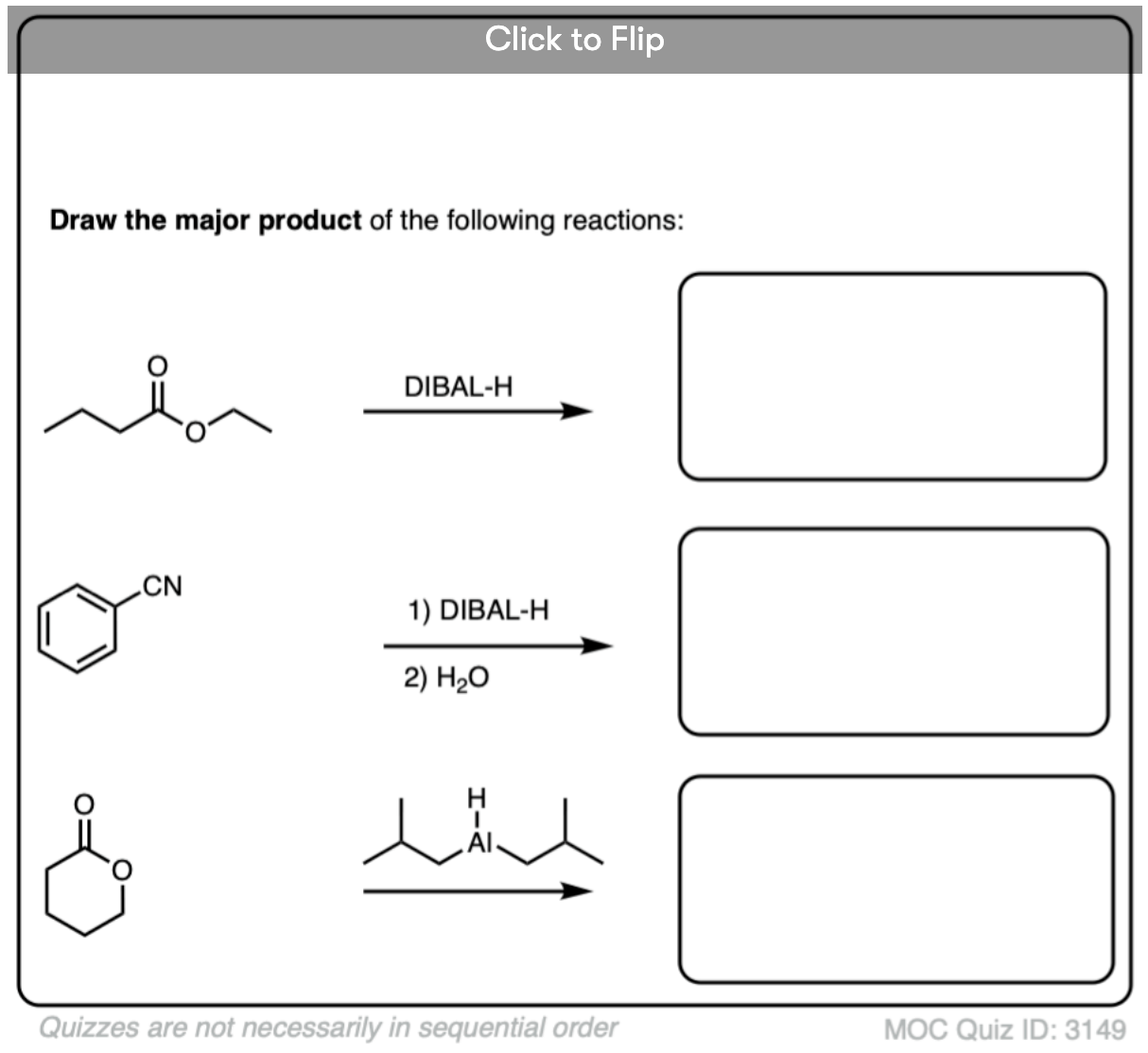
Become a MOC member to see the clickable quiz with answers on the back.
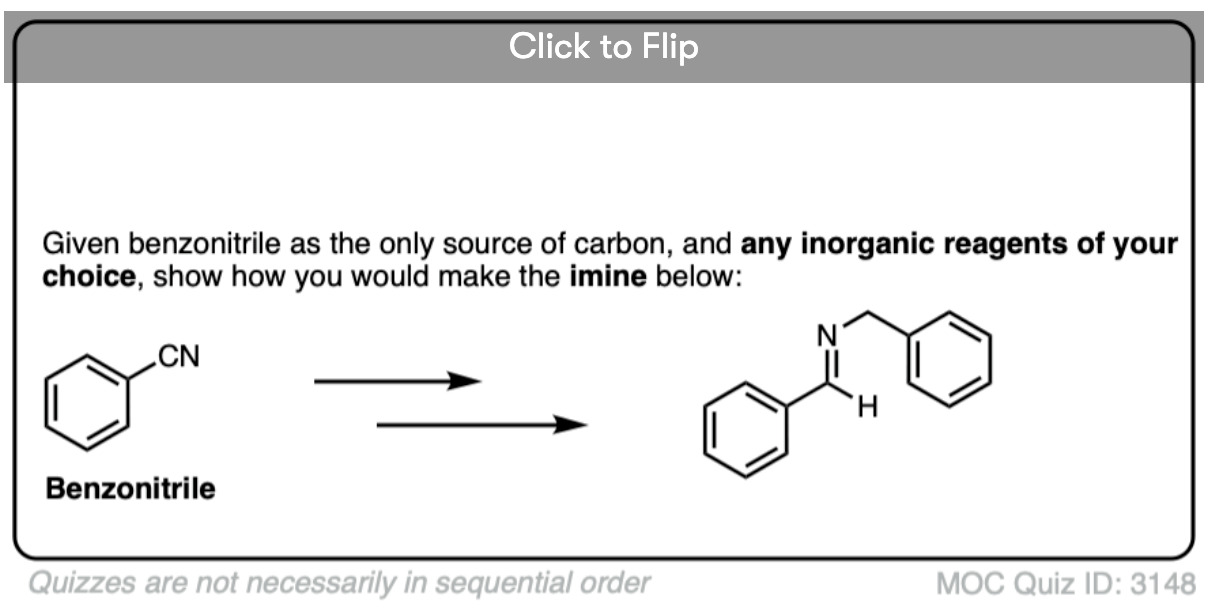
Become a MOC member to see the clickable quiz with answers on the back.
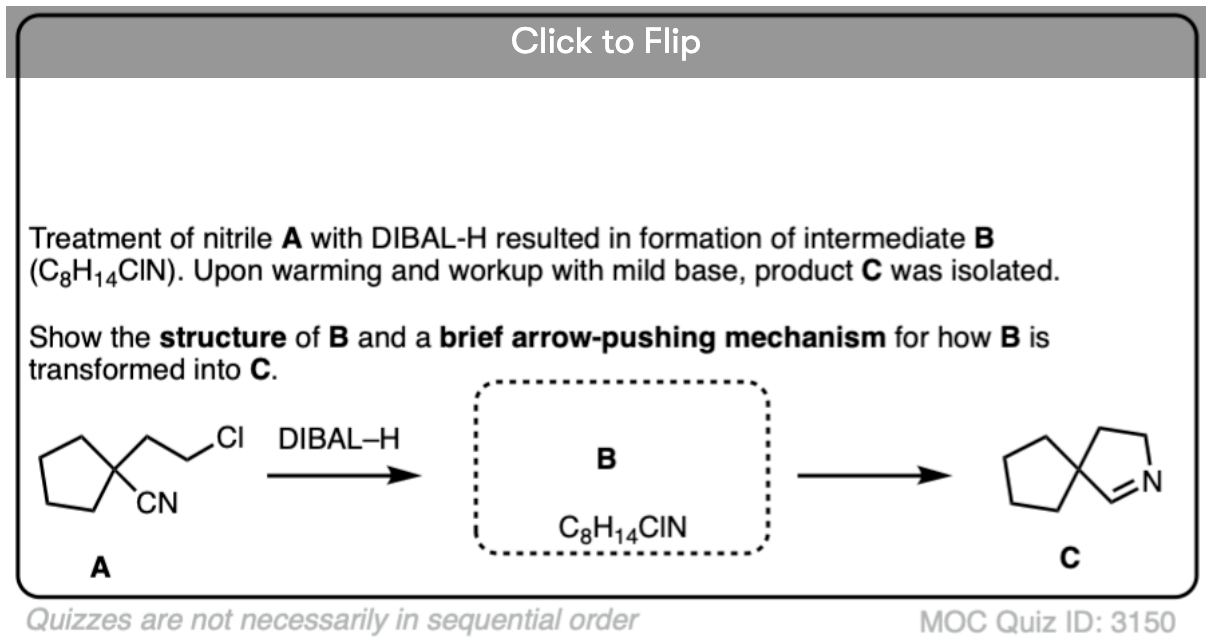
Become a MOC member to see the clickable quiz with answers on the back.
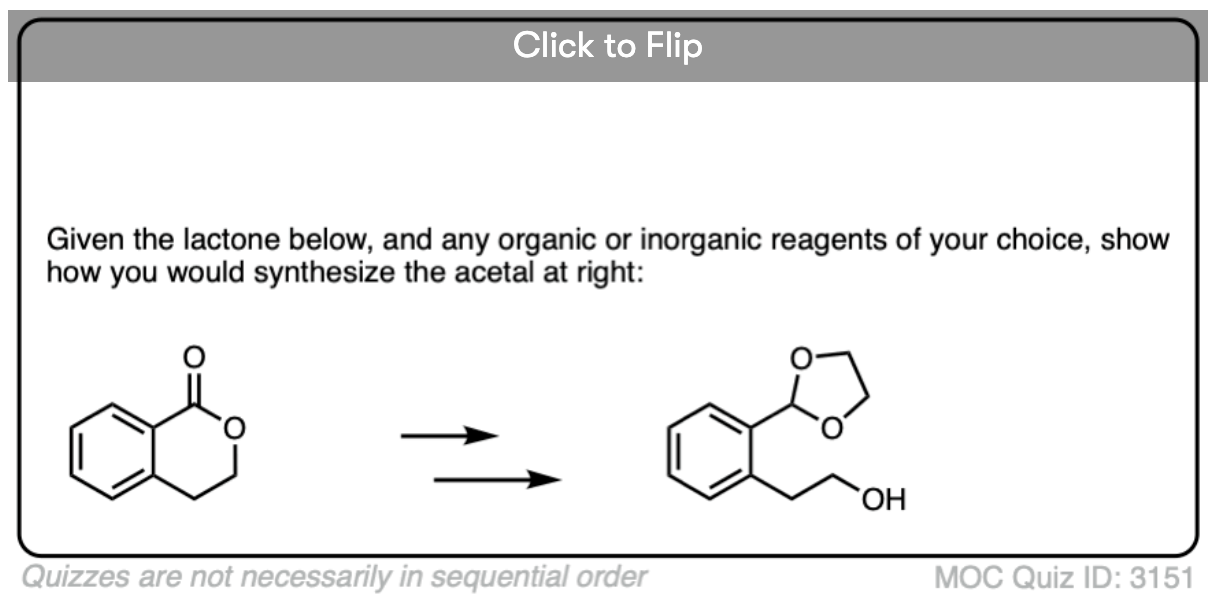
Become a MOC member to see the clickable quiz with answers on the back.
(Advanced) References and Further Reading
- Metallorganische Verbindungen, XXVII Aluminiumtrialkyle und Dialkyl‐Aluminiumhydride Aus Aluminiumisobutyl‐Verbindungen
Ziegler, K.; Martin, H.; Krupp, F. Liebig. Ann. Chem 1960 629 (1), 14-19
DOI: 10.1002/jlac.19606290103
Diisobutyl aluminum hydride (DIBAL or DIBAL-H) was originally investigated by the Nobel Laureate Prof. K. Ziegler as a co-catalyst for the polymerization of alkenes.Two early publications on DIBAL-H reduction of esters: - Reduction of esters of carboxylic acids into aldehydes with diisobutylaluminium hydride
Zakharkin, L. I.; Khorlina, I. M. Lett. 1962, 3 (14), 619-620
DOI: 10.1016/S0040-4039(00)70918-X - Reductions with Dialkylaluminum Hydrides
ALFRED E. G. MILLER, JEAN W. BISS, and LOUIS H. SCHWARTZMAN
The Journal of Organic Chemistry 1959 24 (5), 627-630
DOI: 1021/jo01087a013 - Reaction of diisobutylaluminum hydride with selected organic compounds containing representative functional groups
Nung Min Yoon and Young Soo Gyoung
The Journal of Organic Chemistry 1985 50 (14), 2443-2450
DOI: 1021/jo00214a009
This paper exhaustively covers the reductions of basically every type of functional group in organic chemistry with DIBAL-H. - Applications of Diisobutylaluminium Hydride (DIBAH) and Triisobutylaluminium (TIBA) as Reducing Agents in Organic Synthesis
Ekkehard WINTERFELDT. Synthesis 1975; 1975(10): 617-630
DOI: 1055/s-1975-23856
A classic review on the use of DIBAL-H and triisobutylaluminum in organic synthesis. Even though this might be dated today, it is still a valuable resource. - SYNTHESIS AND UTILIZATION OF INDIUM (I) IODIDE FOR IN SITU FORMATION OF ENANTIOENRICHED ALLENYLINDIUM REAGENTS AND THEIR ADDITION TO ALDEHYDES: (2R,3S,4S)-1-(tert-BUTYLDIPHENYLSILYLOXY)-2,4-DIMETHYL-5-HEXYN-3-OL
Brian A. Johns, Charsetta M. Grant, and James A. Marshall
Org. Synth. 2002, 79, 59
DOI: 10.15227/orgsyn.079.0059
Step C in this procedure is a silyl protection of an alcohol followed by a DIBAL-H reduction of the ester. Note the special workup conditions with Rochelle’s salt (potassium sodium tartrate) required for the DIBAL-H reduction.
00 General Chemistry Review
01 Bonding, Structure, and Resonance
- How Do We Know Methane (CH4) Is Tetrahedral?
- Hybrid Orbitals and Hybridization
- How To Determine Hybridization: A Shortcut
- Orbital Hybridization And Bond Strengths
- Sigma bonds come in six varieties: Pi bonds come in one
- Dipole Moments and Dipoles
- A Key Skill: How to Calculate Formal Charge
- The Four Intermolecular Forces and How They Affect Boiling Points
- 3 Trends That Affect Boiling Points
- How To Use Electronegativity To Determine Electron Density (and why NOT to trust formal charge)
- Introduction to Resonance
- How To Use Curved Arrows To Interchange Resonance Forms
- Evaluating Resonance Forms (1) - The Rule of Least Charges
- How To Find The Best Resonance Structure By Applying Electronegativity
- Evaluating Resonance Structures With Negative Charges
- Evaluating Resonance Structures With Positive Charge
- Exploring Resonance: Pi-Donation
- Exploring Resonance: Pi-acceptors
- In Summary: Evaluating Resonance Structures
- Drawing Resonance Structures: 3 Common Mistakes To Avoid
- How to apply electronegativity and resonance to understand reactivity
- Bond Hybridization Practice
- Structure and Bonding Practice Quizzes
- Resonance Structures Practice
02 Acid Base Reactions
- Introduction to Acid-Base Reactions
- Acid Base Reactions In Organic Chemistry
- The Stronger The Acid, The Weaker The Conjugate Base
- Walkthrough of Acid-Base Reactions (3) - Acidity Trends
- Five Key Factors That Influence Acidity
- Acid-Base Reactions: Introducing Ka and pKa
- How to Use a pKa Table
- The pKa Table Is Your Friend
- A Handy Rule of Thumb for Acid-Base Reactions
- Acid Base Reactions Are Fast
- pKa Values Span 60 Orders Of Magnitude
- How Protonation and Deprotonation Affect Reactivity
- Acid Base Practice Problems
03 Alkanes and Nomenclature
- Meet the (Most Important) Functional Groups
- Condensed Formulas: Deciphering What the Brackets Mean
- Hidden Hydrogens, Hidden Lone Pairs, Hidden Counterions
- Don't Be Futyl, Learn The Butyls
- Primary, Secondary, Tertiary, Quaternary In Organic Chemistry
- Branching, and Its Affect On Melting and Boiling Points
- The Many, Many Ways of Drawing Butane
- Wedge And Dash Convention For Tetrahedral Carbon
- Common Mistakes in Organic Chemistry: Pentavalent Carbon
- Table of Functional Group Priorities for Nomenclature
- Summary Sheet - Alkane Nomenclature
- Organic Chemistry IUPAC Nomenclature Demystified With A Simple Puzzle Piece Approach
- Boiling Point Quizzes
- Organic Chemistry Nomenclature Quizzes
04 Conformations and Cycloalkanes
- Staggered vs Eclipsed Conformations of Ethane
- Conformational Isomers of Propane
- Newman Projection of Butane (and Gauche Conformation)
- Introduction to Cycloalkanes
- Geometric Isomers In Small Rings: Cis And Trans Cycloalkanes
- Calculation of Ring Strain In Cycloalkanes
- Cycloalkanes - Ring Strain In Cyclopropane And Cyclobutane
- Cyclohexane Conformations
- Cyclohexane Chair Conformation: An Aerial Tour
- How To Draw The Cyclohexane Chair Conformation
- The Cyclohexane Chair Flip
- The Cyclohexane Chair Flip - Energy Diagram
- Substituted Cyclohexanes - Axial vs Equatorial
- Ranking The Bulkiness Of Substituents On Cyclohexanes: "A-Values"
- Cyclohexane Chair Conformation Stability: Which One Is Lower Energy?
- Fused Rings - Cis-Decalin and Trans-Decalin
- Naming Bicyclic Compounds - Fused, Bridged, and Spiro
- Bredt's Rule (And Summary of Cycloalkanes)
- Newman Projection Practice
- Cycloalkanes Practice Problems
05 A Primer On Organic Reactions
- The Most Important Question To Ask When Learning a New Reaction
- Curved Arrows (for reactions)
- Nucleophiles and Electrophiles
- The Three Classes of Nucleophiles
- Nucleophilicity vs. Basicity
- What Makes A Good Nucleophile?
- What Makes A Good Leaving Group?
- 3 Factors That Stabilize Carbocations
- Equilibrium and Energy Relationships
- 7 Factors that stabilize negative charge in organic chemistry
- 7 Factors That Stabilize Positive Charge in Organic Chemistry
- What's a Transition State?
- Hammond's Postulate
- Learning Organic Chemistry Reactions: A Checklist (PDF)
06 Free Radical Reactions
- Free Radical Reactions
- 3 Factors That Stabilize Free Radicals
- Bond Strengths And Radical Stability
- Free Radical Initiation: Why Is "Light" Or "Heat" Required?
- Initiation, Propagation, Termination
- Monochlorination Products Of Propane, Pentane, And Other Alkanes
- Selectivity In Free Radical Reactions
- Selectivity in Free Radical Reactions: Bromination vs. Chlorination
- Halogenation At Tiffany's
- Allylic Bromination
- Bonus Topic: Allylic Rearrangements
- In Summary: Free Radicals
- Synthesis (2) - Reactions of Alkanes
- Free Radicals Practice Quizzes
07 Stereochemistry and Chirality
- Types of Isomers: Constitutional Isomers, Stereoisomers, Enantiomers, and Diastereomers
- How To Draw The Enantiomer Of A Chiral Molecule
- How To Draw A Bond Rotation
- Introduction to Assigning (R) and (S): The Cahn-Ingold-Prelog Rules
- Assigning Cahn-Ingold-Prelog (CIP) Priorities (2) - The Method of Dots
- Enantiomers vs Diastereomers vs The Same? Two Methods For Solving Problems
- Assigning R/S To Newman Projections (And Converting Newman To Line Diagrams)
- How To Determine R and S Configurations On A Fischer Projection
- The Meso Trap
- Optical Rotation, Optical Activity, and Specific Rotation
- Optical Purity and Enantiomeric Excess
- What's a Racemic Mixture?
- Chiral Allenes And Chiral Axes
- Stereochemistry Practice Problems and Quizzes
08 Substitution Reactions
- Nucleophilic Substitution Reactions - Introduction
- Two Types of Nucleophilic Substitution Reactions
- The SN2 Mechanism
- Why the SN2 Reaction Is Powerful
- The SN1 Mechanism
- The Conjugate Acid Is A Better Leaving Group
- Comparing the SN1 and SN2 Reactions
- Polar Protic? Polar Aprotic? Nonpolar? All About Solvents
- Steric Hindrance is Like a Fat Goalie
- Common Blind Spot: Intramolecular Reactions
- Substitution Practice - SN1
- Substitution Practice - SN2
09 Elimination Reactions
- Elimination Reactions (1): Introduction And The Key Pattern
- Elimination Reactions (2): The Zaitsev Rule
- Elimination Reactions Are Favored By Heat
- Two Elimination Reaction Patterns
- The E1 Reaction
- The E2 Mechanism
- E1 vs E2: Comparing the E1 and E2 Reactions
- Antiperiplanar Relationships: The E2 Reaction and Cyclohexane Rings
- Bulky Bases in Elimination Reactions
- Comparing the E1 vs SN1 Reactions
- Elimination (E1) Reactions With Rearrangements
- E1cB - Elimination (Unimolecular) Conjugate Base
- Elimination (E1) Practice Problems And Solutions
- Elimination (E2) Practice Problems and Solutions
10 Rearrangements
11 SN1/SN2/E1/E2 Decision
- Identifying Where Substitution and Elimination Reactions Happen
- Deciding SN1/SN2/E1/E2 (1) - The Substrate
- Deciding SN1/SN2/E1/E2 (2) - The Nucleophile/Base
- SN1 vs E1 and SN2 vs E2 : The Temperature
- Deciding SN1/SN2/E1/E2 - The Solvent
- Wrapup: The Key Factors For Determining SN1/SN2/E1/E2
- Alkyl Halide Reaction Map And Summary
- SN1 SN2 E1 E2 Practice Problems
12 Alkene Reactions
- E and Z Notation For Alkenes (+ Cis/Trans)
- Alkene Stability
- Alkene Addition Reactions: "Regioselectivity" and "Stereoselectivity" (Syn/Anti)
- Stereoselective and Stereospecific Reactions
- Hydrohalogenation of Alkenes and Markovnikov's Rule
- Hydration of Alkenes With Aqueous Acid
- Rearrangements in Alkene Addition Reactions
- Halogenation of Alkenes and Halohydrin Formation
- Oxymercuration Demercuration of Alkenes
- Hydroboration Oxidation of Alkenes
- m-CPBA (meta-chloroperoxybenzoic acid)
- OsO4 (Osmium Tetroxide) for Dihydroxylation of Alkenes
- Palladium on Carbon (Pd/C) for Catalytic Hydrogenation of Alkenes
- Cyclopropanation of Alkenes
- A Fourth Alkene Addition Pattern - Free Radical Addition
- Alkene Reactions: Ozonolysis
- Oxidative Cleavage of Vicinal Diols With NaIO4 and Pb(OAc)4
- Summary: Three Key Families Of Alkene Reaction Mechanisms
- Synthesis (4) - Alkene Reaction Map, Including Alkyl Halide Reactions
- Alkene Reactions Practice Problems
13 Alkyne Reactions
- Acetylides from Alkynes, And Substitution Reactions of Acetylides
- Partial Reduction of Alkynes With Lindlar's Catalyst
- Partial Reduction of Alkynes With Na/NH3 To Obtain Trans Alkenes
- Alkyne Hydroboration With "R2BH"
- Hydration and Oxymercuration of Alkynes
- Hydrohalogenation of Alkynes
- Alkyne Halogenation: Bromination and Chlorination of Alkynes
- Oxidation of Alkynes With O3 and KMnO4
- Alkenes To Alkynes Via Halogenation And Elimination Reactions
- Alkynes Are A Blank Canvas
- Synthesis (5) - Reactions of Alkynes
- Alkyne Reactions Practice Problems With Answers
14 Alcohols, Epoxides and Ethers
- Alcohols - Nomenclature and Properties
- Alcohols Can Act As Acids Or Bases (And Why It Matters)
- Alcohols - Acidity and Basicity
- The Williamson Ether Synthesis
- Ethers From Alkenes, Tertiary Alkyl Halides and Alkoxymercuration
- Alcohols To Ethers via Acid Catalysis
- Cleavage Of Ethers With Acid
- Epoxides - The Outlier Of The Ether Family
- Opening of Epoxides With Acid
- Epoxide Ring Opening With Base
- Making Alkyl Halides From Alcohols
- Tosylates And Mesylates
- PBr3 and SOCl2
- Elimination Reactions of Alcohols
- Elimination of Alcohols To Alkenes With POCl3
- Alcohol Oxidation: "Strong" and "Weak" Oxidants
- Demystifying The Mechanisms of Alcohol Oxidations
- Protecting Groups For Alcohols
- Thiols And Thioethers
- Calculating the oxidation state of a carbon
- Oxidation and Reduction in Organic Chemistry
- Oxidation Ladders
- SOCl2 Mechanism For Alcohols To Alkyl Halides: SN2 versus SNi
- Alcohol Reactions Roadmap (PDF)
- Alcohol Reaction Practice Problems
- Epoxide Reaction Quizzes
- Oxidation and Reduction Practice Quizzes
15 Organometallics
- What's An Organometallic?
- Formation of Grignard and Organolithium Reagents
- Organometallics Are Strong Bases
- Reactions of Grignard Reagents
- Protecting Groups In Grignard Reactions
- Synthesis Problems Involving Grignard Reagents
- Grignard Reactions And Synthesis (2)
- Organocuprates (Gilman Reagents): How They're Made
- Gilman Reagents (Organocuprates): What They're Used For
- The Heck, Suzuki, and Olefin Metathesis Reactions (And Why They Don't Belong In Most Introductory Organic Chemistry Courses)
- Reaction Map: Reactions of Organometallics
- Grignard Practice Problems
16 Spectroscopy
- Degrees of Unsaturation (or IHD, Index of Hydrogen Deficiency)
- Conjugation And Color (+ How Bleach Works)
- Introduction To UV-Vis Spectroscopy
- UV-Vis Spectroscopy: Absorbance of Carbonyls
- UV-Vis Spectroscopy: Practice Questions
- Bond Vibrations, Infrared Spectroscopy, and the "Ball and Spring" Model
- Infrared (IR) Spectroscopy: A Quick Primer On Interpreting Spectra
- IR Spectroscopy: 4 Practice Problems
- 1H NMR: How Many Signals?
- Homotopic, Enantiotopic, Diastereotopic
- Diastereotopic Protons in 1H NMR Spectroscopy: Examples
- 13-C NMR - How Many Signals
- Liquid Gold: Pheromones In Doe Urine
- Natural Product Isolation (1) - Extraction
- Natural Product Isolation (2) - Purification Techniques, An Overview
- Structure Determination Case Study: Deer Tarsal Gland Pheromone
17 Dienes and MO Theory
- What To Expect In Organic Chemistry 2
- Are these molecules conjugated?
- Conjugation And Resonance In Organic Chemistry
- Bonding And Antibonding Pi Orbitals
- Molecular Orbitals of The Allyl Cation, Allyl Radical, and Allyl Anion
- Pi Molecular Orbitals of Butadiene
- Reactions of Dienes: 1,2 and 1,4 Addition
- Thermodynamic and Kinetic Products
- More On 1,2 and 1,4 Additions To Dienes
- s-cis and s-trans
- The Diels-Alder Reaction
- Cyclic Dienes and Dienophiles in the Diels-Alder Reaction
- Stereochemistry of the Diels-Alder Reaction
- Exo vs Endo Products In The Diels Alder: How To Tell Them Apart
- HOMO and LUMO In the Diels Alder Reaction
- Why Are Endo vs Exo Products Favored in the Diels-Alder Reaction?
- Diels-Alder Reaction: Kinetic and Thermodynamic Control
- The Retro Diels-Alder Reaction
- The Intramolecular Diels Alder Reaction
- Regiochemistry In The Diels-Alder Reaction
- The Cope and Claisen Rearrangements
- Electrocyclic Reactions
- Electrocyclic Ring Opening And Closure (2) - Six (or Eight) Pi Electrons
- Diels Alder Practice Problems
- Molecular Orbital Theory Practice
18 Aromaticity
- Introduction To Aromaticity
- Rules For Aromaticity
- Huckel's Rule: What Does 4n+2 Mean?
- Aromatic, Non-Aromatic, or Antiaromatic? Some Practice Problems
- Antiaromatic Compounds and Antiaromaticity
- The Pi Molecular Orbitals of Benzene
- The Pi Molecular Orbitals of Cyclobutadiene
- Frost Circles
- Aromaticity Practice Quizzes
19 Reactions of Aromatic Molecules
- Electrophilic Aromatic Substitution: Introduction
- Activating and Deactivating Groups In Electrophilic Aromatic Substitution
- Electrophilic Aromatic Substitution - The Mechanism
- Ortho-, Para- and Meta- Directors in Electrophilic Aromatic Substitution
- Understanding Ortho, Para, and Meta Directors
- Why are halogens ortho- para- directors?
- Disubstituted Benzenes: The Strongest Electron-Donor "Wins"
- Electrophilic Aromatic Substitutions (1) - Halogenation of Benzene
- Electrophilic Aromatic Substitutions (2) - Nitration and Sulfonation
- EAS Reactions (3) - Friedel-Crafts Acylation and Friedel-Crafts Alkylation
- Intramolecular Friedel-Crafts Reactions
- Nucleophilic Aromatic Substitution (NAS)
- Nucleophilic Aromatic Substitution (2) - The Benzyne Mechanism
- Reactions on the "Benzylic" Carbon: Bromination And Oxidation
- The Wolff-Kishner, Clemmensen, And Other Carbonyl Reductions
- More Reactions on the Aromatic Sidechain: Reduction of Nitro Groups and the Baeyer Villiger
- Aromatic Synthesis (1) - "Order Of Operations"
- Synthesis of Benzene Derivatives (2) - Polarity Reversal
- Aromatic Synthesis (3) - Sulfonyl Blocking Groups
- Birch Reduction
- Synthesis (7): Reaction Map of Benzene and Related Aromatic Compounds
- Aromatic Reactions and Synthesis Practice
- Electrophilic Aromatic Substitution Practice Problems
20 Aldehydes and Ketones
- What's The Alpha Carbon In Carbonyl Compounds?
- Nucleophilic Addition To Carbonyls
- Aldehydes and Ketones: 14 Reactions With The Same Mechanism
- Sodium Borohydride (NaBH4) Reduction of Aldehydes and Ketones
- Grignard Reagents For Addition To Aldehydes and Ketones
- Wittig Reaction
- Hydrates, Hemiacetals, and Acetals
- Imines - Properties, Formation, Reactions, and Mechanisms
- All About Enamines
- Breaking Down Carbonyl Reaction Mechanisms: Reactions of Anionic Nucleophiles (Part 2)
- Aldehydes Ketones Reaction Practice
21 Carboxylic Acid Derivatives
- Nucleophilic Acyl Substitution (With Negatively Charged Nucleophiles)
- Addition-Elimination Mechanisms With Neutral Nucleophiles (Including Acid Catalysis)
- Basic Hydrolysis of Esters - Saponification
- Transesterification
- Proton Transfer
- Fischer Esterification - Carboxylic Acid to Ester Under Acidic Conditions
- Lithium Aluminum Hydride (LiAlH4) For Reduction of Carboxylic Acid Derivatives
- LiAlH[Ot-Bu]3 For The Reduction of Acid Halides To Aldehydes
- Di-isobutyl Aluminum Hydride (DIBAL) For The Partial Reduction of Esters and Nitriles
- Amide Hydrolysis
- Thionyl Chloride (SOCl2) And Conversion of Carboxylic Acids to Acid Halides
- Diazomethane (CH2N2)
- Carbonyl Chemistry: Learn Six Mechanisms For the Price Of One
- Making Music With Mechanisms (PADPED)
- Carboxylic Acid Derivatives Practice Questions
22 Enols and Enolates
- Keto-Enol Tautomerism
- Enolates - Formation, Stability, and Simple Reactions
- Kinetic Versus Thermodynamic Enolates
- Aldol Addition and Condensation Reactions
- Reactions of Enols - Acid-Catalyzed Aldol, Halogenation, and Mannich Reactions
- Claisen Condensation and Dieckmann Condensation
- Decarboxylation
- The Malonic Ester and Acetoacetic Ester Synthesis
- The Michael Addition Reaction and Conjugate Addition
- The Robinson Annulation
- Haloform Reaction
- The Hell–Volhard–Zelinsky Reaction
- Enols and Enolates Practice Quizzes
23 Amines
- The Amide Functional Group: Properties, Synthesis, and Nomenclature
- Basicity of Amines And pKaH
- 5 Key Basicity Trends of Amines
- The Mesomeric Effect And Aromatic Amines
- Nucleophilicity of Amines
- Alkylation of Amines (Sucks!)
- Reductive Amination
- The Gabriel Synthesis
- Some Reactions of Azides
- The Hofmann Elimination
- The Hofmann and Curtius Rearrangements
- The Cope Elimination
- Protecting Groups for Amines - Carbamates
- The Strecker Synthesis of Amino Acids
- Introduction to Peptide Synthesis
- Reactions of Diazonium Salts: Sandmeyer and Related Reactions
- Amine Practice Questions
24 Carbohydrates
- D and L Notation For Sugars
- Pyranoses and Furanoses: Ring-Chain Tautomerism In Sugars
- What is Mutarotation?
- Reducing Sugars
- The Big Damn Post Of Carbohydrate-Related Chemistry Definitions
- The Haworth Projection
- Converting a Fischer Projection To A Haworth (And Vice Versa)
- Reactions of Sugars: Glycosylation and Protection
- The Ruff Degradation and Kiliani-Fischer Synthesis
- Isoelectric Points of Amino Acids (and How To Calculate Them)
- Carbohydrates Practice
- Amino Acid Quizzes
25 Fun and Miscellaneous
- A Gallery of Some Interesting Molecules From Nature
- Screw Organic Chemistry, I'm Just Going To Write About Cats
- On Cats, Part 1: Conformations and Configurations
- On Cats, Part 2: Cat Line Diagrams
- On Cats, Part 4: Enantiocats
- On Cats, Part 6: Stereocenters
- Organic Chemistry Is Shit
- The Organic Chemistry Behind "The Pill"
- Maybe they should call them, "Formal Wins" ?
- Why Do Organic Chemists Use Kilocalories?
- The Principle of Least Effort
- Organic Chemistry GIFS - Resonance Forms
- Reproducibility In Organic Chemistry
- What Holds The Nucleus Together?
- How Reactions Are Like Music
- Organic Chemistry and the New MCAT
26 Organic Chemistry Tips and Tricks
- Common Mistakes: Formal Charges Can Mislead
- Partial Charges Give Clues About Electron Flow
- Draw The Ugly Version First
- Organic Chemistry Study Tips: Learn the Trends
- The 8 Types of Arrows In Organic Chemistry, Explained
- Top 10 Skills To Master Before An Organic Chemistry 2 Final
- Common Mistakes with Carbonyls: Carboxylic Acids... Are Acids!
- Planning Organic Synthesis With "Reaction Maps"
- Alkene Addition Pattern #1: The "Carbocation Pathway"
- Alkene Addition Pattern #2: The "Three-Membered Ring" Pathway
- Alkene Addition Pattern #3: The "Concerted" Pathway
- Number Your Carbons!
- The 4 Major Classes of Reactions in Org 1
- How (and why) electrons flow
- Grossman's Rule
- Three Exam Tips
- A 3-Step Method For Thinking Through Synthesis Problems
- Putting It Together
- Putting Diels-Alder Products in Perspective
- The Ups and Downs of Cyclohexanes
- The Most Annoying Exceptions in Org 1 (Part 1)
- The Most Annoying Exceptions in Org 1 (Part 2)
- The Marriage May Be Bad, But the Divorce Still Costs Money
- 9 Nomenclature Conventions To Know
- Nucleophile attacks Electrophile
27 Case Studies of Successful O-Chem Students
- Success Stories: How Corina Got The The "Hard" Professor - And Got An A+ Anyway
- How Helena Aced Organic Chemistry
- From a "Drop" To B+ in Org 2 – How A Hard Working Student Turned It Around
- How Serge Aced Organic Chemistry
- Success Stories: How Zach Aced Organic Chemistry 1
- Success Stories: How Kari Went From C– to B+
- How Esther Bounced Back From a "C" To Get A's In Organic Chemistry 1 And 2
- How Tyrell Got The Highest Grade In Her Organic Chemistry Course
- This Is Why Students Use Flashcards
- Success Stories: How Stu Aced Organic Chemistry
- How John Pulled Up His Organic Chemistry Exam Grades
- Success Stories: How Nathan Aced Organic Chemistry (Without It Taking Over His Life)
- How Chris Aced Org 1 and Org 2
- Interview: How Jay Got an A+ In Organic Chemistry
- How to Do Well in Organic Chemistry: One Student's Advice
- "America's Top TA" Shares His Secrets For Teaching O-Chem
- "Organic Chemistry Is Like..." - A Few Metaphors
- How To Do Well In Organic Chemistry: Advice From A Tutor
- Guest post: "I went from being afraid of tests to actually looking forward to them".
in one jee qn dibal h was not able to reduce cooh, so am confused it can make all derivatives of acid aldehyde n alcohol except cooh
Carboxylic acids are acidic, so the first equivalent of hydride will react with COOOH to give a carboxylate ion and H2. The COO(-) is unreactive towards DIBAL.
What will be the temperature required if a reaction occurs between 3-butenenitrile and DIBAL-H to form aldehyde?
Generally you start at -78 °C and let it warm from there.
What about the acid reduction? It requires 3 moles??
The acid workup? Yes, at least 3 moles of acid should be required but in practice more are often used.
I read somewhere there is DIBAL-A also just like DIBAL-H ,so please tell difference between them and also the work of DIBAL-A
DIBAL and DIBAL-H are the same thing for our purposes.
I have never heard of DIBAL-A and have no idea what it could possibly mean.
There is such a thing as RED-Al but that’s different. https://en.wikipedia.org/wiki/Sodium_bis(2-methoxyethoxy)aluminium_hydride
How can Dibal H reduce an aldehyde and a ketone to their corresponding alcohols at once which are present in a single compound but not ester to alcohol provided 1 equivalent? (Since, DIBAL H has only 1 hydride)
DIBAL can in fact reduce esters to alcohols even with only one equivalent; what happens first is the conventional hydride reduction. The second reduction is a type of Meerwein-Ponndorf-Verley reduction where there is hydride transfer from the isobutyl group.
May you also expand further to include DIBAL reductions on a,b-unsaturated esters?
Do the same rules apply or do we get the alcohol?
If so, why?
Hi – yes, DIBAL will do partial reduction of alpha, beta unsaturated esters to give the aldehyde. Amides too.
The alkene is untouched.
Even if the aldehyde is over-reduced to the alcohol, there are plenty of ways to go from the allylic alcohol back up to the aldehyde.
What happens when acid reacted with one equivalent of dibal h at room temperature
DIBAL-H is a source of hydride ion, a strong base. What do you think happens?
Thanks James for your reply
I could not understand how the intermediate qualifies to be called a hemiacetal. I mean where is the -OH group of the general formula R1HC(OH)OR2
It’s essentially the conjugate base of a hemiacetal, where Al is coordinated to the oxygen instead of H.
U said in a comment that to reduce carboxylic acid, one can use NABH4… Is that correct?
Carboxylic acid is reduced easily by LIAlH4 and diborane only.
No, NaBH4 cannot reduce carboxylic acids. You are correct about LiAlH4 and BH3
You can break the aluminum complex by refluxing in methanol. DIBAL 2 eq. at zero deg reduces ester to alcohol. 1 Eq DIBAL at -78 reduces esters to aldehyde. those reactions are clean. yields are more than 90 %. after refluxing with methanol one can do celite filtration and concentrate the methanol extract..no need to even do a column. Of course there should be no other competing groups.
In my experience getting it to stop at the aldehyde can be capricious and quite solvent dependent. Refluxing in methanol seems extreme… why not just use Rochelle’s salt like everybody else?
So.. using DIBAL-H on an ester, gives us an aldehyde. What about the other organic part of the ester? [RCOOR’] What about The R’ part? We get an Alcohol [OR’] I suppose?
Yes, that is correct.
In one of the comments its mentioned to use LiAlH4 for reduction of carboxylic acid and why is that? why not better with Dibal
It’s inefficient. LiAlH4 is considerably cheaper and you have to use fewer equivalents of it.
Is it possible to reduce ethyl ester to aldehyde in presence of an aromatic nitro group?
Did “dibal h ” reduce acid chlorides?
Yes, it should give an aldehyde.
I was also wondering if DIBAL-H can be used to reduce carboxylic acids?! If it does, would the product be an aldehyde like it is when we reduce an ester with DIBAL-H?
You’d really have to crank on it. It’s possible, but you’d have to use over 3 equivalents and heat it up. It’s far superior to use LiAlH4 !
In the mechanism of Dibal reduction, from ester to aldehyde, we know that OCH3 is a bad leving group but it still goes out. Plz explain how?? I have to explain this dibal mechanism in my seminar
DIBAL reduction produces O(-) which itself is a strong base. The formation of the C-O double bond along with expulsion of CH3O(-) is therefore not accompanied by a huge energy barrier. CH3O(-) is not a great leaving group, but still a much better one than H(-) or most carbon-based leaving groups.
Hi,
I want to reduce an ester to an aldehyde.
I’ll try DIBAL at -78°C in DCM.
If it doesn’t work, I’ll do the reduction to alcohol then oxidize with PCC.
My questions :
1) I thought non polar solvent would make the reaction slower. Then should I use toluene instead of DCM ?
2) If going to alcohol, why -78°C ? Can’t I do it at 0°C ?
And should I add the ester to the dibal or the opposite ?
3) Last question, if I go to aldehyde, can I quench with methanol ? Water will be frozen at -78°C.
Also, what do you think about the paper adding NaOtBu to Dibal to reduce to aldehyde at 0°C ?
Thanks a lot
I’d look for a prep online where someone successfully reduced an ester to an aldehyde. For example, if you go to the ACS Publications home page, search for “ester dibal reduction aldehyde total synthesis ” . You’ll come up with some reputable papers with supporting information. Use those conditions.
Follow this, for instance: http://pubs.acs.org/action/doSearch?text1=baran+ester+reduction+aldehyde+dibal&field1=AllField
If you want the aldehyde, you MUST keep it at -78. A non polar solvent is ideal. Avoid ethereal solvents (they tend to coordinate to the aluminum and this can affect reactivity), DCM should be fine. Toluene can present solubility problems, but might be OK for you at -78. If you are aiming for the alcohol, then warming is fine.
I haven’t come across the paper you mention at the end.
In the last step of preperation of aldehydes from alkyl nitrile, how ammonia(NH3) is formed – I mean , where is an additional hydrogen proton (H+) available to form NH3? Thanks in advance.
It would come in the workup step when water is added. There’s excess water.
You usually use a couple of eqivs of dibal to reduce ester to aldehyde not 1 eq as stated above. The important thing is to keep the temp low [<-50] and quench at low temps (Ihave al3ways used MeOH to quenchrather than water – water will freeze at this temp!)
Just using 1eq would not help anyway as the aldehyde is more facile to reduce than the ester.
Love the site and have learnt a lot from it so far :)
Dibal has another trick up its sleeve. If you have an a,b-unsat. ester or ketone, it can cleanly reduce without affecting the double bond. Unlike NaBH4 or LAH.
Actualy, I have just used 2 eq. of DIBAL by accident in calculating and got 100% of alcohol and not a trace of aldehyde, so I wouldnt be so hasty with more than 1 eq.
Does this also reduce carboxylic acids?
No, DIBAL-H does not react with carboxylic acids. You have two options: perform an esterification of your -COOH to -COOMe for example and then use DIBAL-H, or you can use the -COOH directly with another reagent like LiAlH4 or NaBH4.
Yes. Thanks Chris!
i used 6 year old DIBAL for opening up my isopropyldene ring itwas working fantastic but when i used new Dibal it producing unusual reports does anyone feel any prb like this
what can be degraded product of DIBAL-H ?
Does your DIBAL acquire an extra carbon atom when it coordinates the oxygen?
Shoot. Yes, it does. Fixed
I use 2,5-3,5 eq to reduce my esters to alcohols. So no, it doesn’t stop at aldehyde, it’s actually more difficult to stop the reduction at aldehyde than to continue to alcohol.
thats because you use more then ONE eq.
can you demonstrate how hydrolysis occurs? im a little stuck
Under the acidic conditions, convert the aluminum salt to the hemiacetal. Don’t worry, students have this problem all the time because, well, they just do. When we grade quizzes, students freak out when they see the hemiacetal under acid conditions and they are unable to figure out what to do next. Then the students proceed to use OH- because remember in student parlance, OH- is always available in acidic solution.
Can we obtain alcohol from ketone, by DIBAH at –70°C? I know we can at room temperature, but I don’t know if we can at –70°C. Any reference you have?
Is it not DIBAH instead of DIBAL?
It can be referred to as DIBAH, DIBAL, or DIBAL-H. Usually when discussing it amongst themselves, organic chemists call it DIBAL because it rolls more easily off the tongue than either of the other two.
I personally was not able to obtain an aldehyde on the one occasion I tried DIBAL. Part of the problem was likely the scale (<25 mg) and titre of the (old) DIBAL, as well as not choosing the solvent well (should have used CH2Cl2 instead of ether). So I just re-oxidized the alcohol with DMP and was done with it.
Aluminum salts are notorious for their bitching emulsions. For DIBAL I made sure to stir with Rochelle's salt for a good long while. For LiAlH4 I always use the Fieser workup and filter off the solid… no extraction required, thank goodness.
To be complete, I wasn’t reducing an ester, it was a thioimide. It was an (OH-protected) aldol adduct utilizing a thiazolidinethione as a chiral auxiliary. We developed the conditions for the aldol addition in our laboratory. Suffice it to say we did the diastereoselective aldol addition a lot. Partial reduction of the thioimide to the aldehyde was a common next transformation, so we always had a fresh bottle of DIBAL in the fridge. I reduced 5 different thioimides this way who knows how many times as I ran through the synthetic scheme who knows how many times.
The one time I did reduce an actual ester, it was on 0.7 g scale (2.4 mmol). 68% yield of aldehyde, 30% yield of alcohol. Also reoxidized the alcohol with DMP back to the aldehyde in 63% (or 87% total from ester -> aldehdye) That reduction was following a Frater-Seebach alkylation (which was a pain to run (-40 degC, 3 days), but a great reaction to have experienced.
re: real life disclaimer. And man those hydrolized aluminum salts are some of the nastiest emulsions I’ve ever experienced!
According to my dissertation, my largest DIBAL-H reduction ran on 10.1 g (17.9 mmol) in 175 mL CH2Cl2. The good news about this reaction for me are twofold. 1) The starting material is bright crayon yellow and the product was colorless. 2) The reaction was instantaneous. It was like titrating in DIBAL-H. Curiously, it always took 2 eq of DIBAL (still not quite sure why, only one equiv of H- is incorporated), but as soon as the yellow disappeared, I was sure the reaction was at 100% conversion. Sure, I’d take a TLC just to be sure, and it was always complete.
Then quench the reaction with saturated aq. Rochelle’s salt (hm… TIL Rochelle was the city in which it was discovered, not the name of the guy) to help break the Al emulsion. Our lab also found empirically that diluting the CH2Cl2 reaction with a LOT of Et2O helped break the emulsion. The bad news is you had to let this biphasic mixture stir vigorously for at least 90 min-2hr before separating the layers. As long as enough Et2O was added, the emulsion broke down and separation became very manageable if stirred long enough.
(In case you were wondering, 92% yield of the aldehyde with 93% recovery of the ‘other side’ of the ester (it was a precious chiral auxiliary, and we wanted to reuse it!)
I’ve done a few DIBAL reductions this year and often had trouble with them – in particular, if your product is water soluble and loves the aqueous phase in a work-up (one can never quite tell), then it’s an absolutely horrible to job to try and recover it from a saturated aqueous phase full of Rochelle salts.
Somebody recommended to me that the Fieser work up followed by a filtration over Celite should remove the Al salts emulsion just as well. I am probably going to use this method as a first choice from now on, because trying to extract my product from Rochelle salts solution caused me a lot of grief!
Also, having re-read this site properly, I will now always use H2O to quench my DIBAL reductions of nitriles. I mistakenly used methanol earlier on and looking at the mechanism of imine hydrolysis above, that might explain why I got a nasty mixture of crap when I quenched the imine with Methanol! Guess I can just pour the reaction on to water at 0 Celsius, rather than quenching direct at -70.